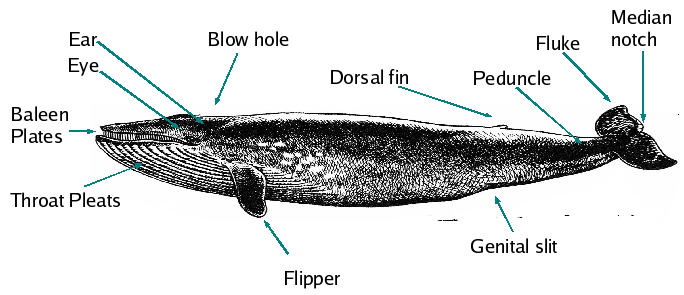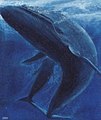Difference between revisions of "AY Honors/Cetaceans/Answer Key"
m (fix tag) |
(new image for bottlenose, replace Image with File) |
||
| Line 108: | Line 108: | ||
==8. Be able to identify at least fifteen Cetaceans.== | ==8. Be able to identify at least fifteen Cetaceans.== | ||
<gallery> | <gallery> | ||
| − | + | File:Faroe stamp 402 blue whale (Balaenoptera musculus) crop.jpg|Blue Whale | |
| − | + | File:Bowheads42.jpg|Bowhead Whale | |
| − | + | File:Eubalaena japonica drawing.jpg|Right Whale | |
| − | + | File:PilotWhale.jpg|Pilot Whale | |
| − | + | File:Humpback Whale underwater shot.jpg|Humpback Whale | |
| − | + | File:Sperm whale1b.jpg|Sperm Whale | |
| − | + | File:Kogia_breviceps.jpg|Pygmy Sperm Whale | |
| − | + | File:Common dolphin.jpg|Common Dolphin | |
| − | + | File:Bottlenose Dolphin KSC04pd0178 head only.JPG|Bottlenose Dolphin | |
| − | + | File:ModelWhite-beaked Dolphin.jpg|White-beaked Dolphin | |
| − | + | File:Tuemmler-drawing.jpg|Porpoise | |
| − | + | File:Orca 2.jpg|Orca (Killer Whale) | |
| − | + | File:Delphinapterus leucas head 3.jpg|Beluga Whale | |
| − | + | File:Narwhals breach.jpg|Narwhal | |
| − | + | File:Minke.jpg|Minke Whale | |
| − | + | File:Greywhale845.jpg|Grey Whale | |
</gallery> | </gallery> | ||
Revision as of 23:26, 30 December 2011
1. In what way is the Cetaceans family different from most other sea life?
The Cetacean family is different from most other sea life because Cetaceans are mammals. This means :
- A: They give birth to live babies. The largest whale is the Blue Whale and its newborn baby will be up to 7 meters long and weigh up to 2700kg, (about as much as two cars).
- The large whale mothers move to warm tropical waters to give birth and spend about six months there so their babies can grow a layer of fat (blubber) to help them survive the cold frigid waters where they live for the other six months. While in the warm waters the adult whales do not eat at all.
- B: They feed their babies milk. The baby will drink 400 liters of milk and gain 90kg a day for the first seven months of its life.
- C: They have warm blood. A blue whale’s heart is the size of a small car and its aorta (the main heart artery) is the diameter of a netball.
- D: They breathe air just like us. This means that they must hold their breath while under the water. A Sperm Whale can hold its breath for 30 minutes. When they want to breathe they come to the surface, blow out moist air from their lungs and snatch a new breath. Their nostrils are called blowholes. Baleen whales have two blowholes and toothed whales one blowhole. The whale hunters could tell what sort of whale it was by the shape of the spout blown out.
- E: They have some hair on their bodies. You may not easily see the hair on a whale but most have small whiskers on the chin.
In addition to the characteristics of mammals listed above, cetaceans differ from other sea life in other ways as well. One of these differences between a cetacean and a fish is the shape of the tail. The tail of a fish is vertical and moves from side to side when the fish swims. The tail of a cetacean – called a "fluke" – is horizontal and moves up and down.
2. Explain the difference between Baleen and Toothed Whales.
Baleen Whales
The baleen whales, also called whalebone whales or great whales, are one of two suborders of the Cetacea (whales, dolphins and porpoises). Baleen whales, rather than having teeth, have baleen plates which hang from the upper jaw and are used for filtering food from water. This distinguishes them from the toothed whales. Baleen is a type of hair but stiff like a soft fingernail. It grows from the roof of the mouth in two rows and is used to filter out food from water. The whale is able to take in a huge mouthful of water and then squeeze its mouth shut and squeeze out the water while straining out the food. Baleen whales feed on tiny creatures called krill and need lots of these to fuel their bodies. Most of the big whales are baleen whales, e.g. Blue whale, humpback whale and fin whale. Krill is one of their major foods, which they strain through their baleen.
Baleen whales are generally larger than toothed whales, and females are larger than males. This group includes the Blue Whale, the largest animal species that has ever lived. Baleen whales have two blowholes, causing a V-shaped blow whereas toothed whales have a single blowhole.
Toothed Whales
The toothed whales have teeth because they feed on creatures much larger than krill, such as squid, fish seals and even other whales. These whales are the dolphins and porpoises, the killer whale and the giant sperm whale.
Dolphins and porpoises mainly feed on fish and may hunt in groups called pods.
Killer whales eat seals, fish, dolphins and even blue whales. They are called the Wolves of the Sea.
The sperm whale is the largest toothed whale. It will eat fish and octopus but its favourite food is giant squid that live in the deep ocean. A sperm whale has been known to dive to 3200 meters looking for squid.
3. In what way have Whales and Dolphins been a benefit to man?
In some cultures, whales provide meat for both pets and for humans. Whales also provide oil for fuel, perfumes, and other products. Entire communities were established devoted to whaling. Although whaling is now illegal in most parts of the world, whales continue to provide benefits to man. They are a major tourist attraction in areas where they are common, and an entire industry has sprung up to bring people to see the whales.
There are many stories of dolphins protecting shipwrecked sailors against sharks by swimming circles around the swimmers. Because of their high capacity for learning, dolphins have been employed by humans for any number of purposes. Dolphins trained to perform in front of an audience have become a favorite attraction at many aquariums, for example SeaWorld. Such places may sometimes also provide an opportunity for humans to interact very closely with Dolphins. Dolphin/Human interaction is also employed in a curative sense at places where dolphins work with autistic or otherwise disabled children. The military has employed dolphins for various purposes from finding mines to rescuing lost or trapped persons.
4. Explain how it is that a Whale which breeds in the warm waters of the tropics can also survive the ice cold water of the Antarctica where they go to feed, (considering the whale is a warm blooded mammal like humans).
Whales have a very thick layer of fat beneath their skin called blubber. Blubber is a very effective insulator, much like a wet suit which is used for keeping divers warm when they swim in cold waters. Blubber is far more effective than a wet suit because it is so thick. In fact, blubber can comprise up to 50% of the body mass of some cetaceans during some points in their lives. Blubber also serves as a source of energy, and whales metabolize (burn) fat to generate heat internally and thus warm themselves. People metabolize fat too when they shiver (shivering serves the same purpose - to warm us up).
5. Memorize the following Scriptures concerning whales:
- a. Genesis 1:21
So God created the great creatures of the sea and every living and moving thing with which the water teems, according to their kinds, and every winged bird according to its kind. And God saw that it was good.
- b. Ezekiel 32:2
- Son of man, take up a lament concerning Pharaoh king of Egypt and say to him:
- " 'You are like a lion among the nations;
- you are like a monster in the seas
- thrashing about in your streams,
- churning the water with your feet
- and muddying the streams.
- c. Job 7:12
- Am I the sea, or the monster of the deep,
- that you put me under guard?
- d. Matthew 12:40
- For as Jonah was three days and three nights in the belly of a huge fish, so the Son of Man will be three days and three nights in the heart of the earth.
6. Write and read to a group, or tell from memory, the story of Jonah.
If you are teaching this honor to your unit, you can have them retell the story (and act it out) for worship at a campout or at a regular meeting. You can also have your Pathfinders tell the story during regular church service if your church has a time allotted for "Children's Story". Alternately, you can have them write it out and read it back to you (or to the group).
7. Successfully draw a Baleen Whale and identify where the following body parts are:
- a. Baleen Plates
- These are the "strainers" in a baleen whale's mouth.
- b. Blowhole
- A cetacean breaths through this little hole in the top of its head.
- c. Dorsal Fin
- The fin on the top of many cetaceans.
- d. Ear
- These are hard to see because they're so small, but cetaceans all have them on the sides of their heads.
- e. Eye
- The better to see you with!
- f. Throat Pleats
- These are the folds in a baleen whale's throat and allow the whale's throat to expand when it fills its mouth with water to filter its food through its baleen.
- g. Flukes
- The tail.
- h. Flippers
- The fins on the side.
- i. Genital Slit
- The reproductive organ of a female cetacean.
- j. Median Notch
- The notch in the middle of the trailing edge of the fluke.
- k. Peduncle
- The part of the body to which the fluke is attached.
8. Be able to identify at least fifteen Cetaceans.
- Sperm whale1b.jpg
Sperm Whale
- Narwhals breach.jpg
Narwhal
References
Wikipedia articles
Other references
Notes
This honor is very similar to Marine Mammals. Why not teach them both at the same time?












